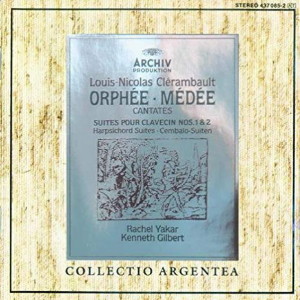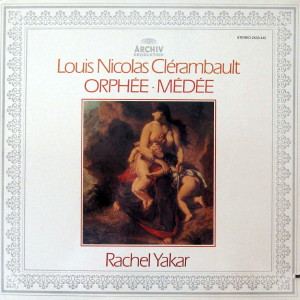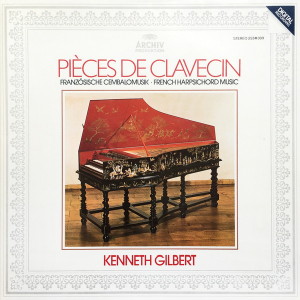 |
|
1 CD -
437 085-2 - (c) 1986
|
 |
| 1 LP -
2533 442 - (p) 1980 |
 |
| 1 LP -
2534 009- (p) 1982 |
|
| LOUIS-NICOLAS
CLÉRAMBAULT - Cantates · Suites pour
Nos. 1 & 2 |
|
|
|
|
|
| Louis-Nicolar
Clérambault (1676-1749) |
|
|
| Orphée |
18' 20" |
|
| - Récitatif: "Le
fameax chantre de la Thrace" ·
Air: "Fidèles Echos" |
3'
15" |
|
| - Récitatif: "Mais
que sert à mon désespoir" · Air:
"Allez Orphée" |
4'
17" |
|
| - Récitatif:
"Cependant le Hèros arrive" · Air:
"Monarque redouté" |
7'
29" |
|
| - Récitatif:
"Pluton surpris" · Air: "Chantez
la victoire" |
3'
19" |
|
| Médée |
20'
07" |
|
| - Récitatif:
"L'Amante de Jason" · Prélude:
"Non, non, n'écoutons plus" · Air:
"Courons, courons à la vengeance" |
5'
36" |
|
| - Récitatif: "Que
dis-je" · Air: "L'Amour dans ses
fers" |
2'
51" |
|
| - Récitatif: "Mais
quelle est mon erreur" · Air:
"Cruelle fille des Enfers" |
6'
37" |
|
| - Récitatif: "Le
charme est fait" · Air: "Volez
Démons" |
5'
05" |
|
|
|
|
Suite N° 1 en ut
mineur *
|
16' 58" |
|
| 1. Prélude |
2'
06" |
|
| 2. Allemande. Gay
- Double |
3'
29" |
|
| 3. Courante |
1'
39" |
|
| 4. 1ère Sarabande.
Fort grave |
2'
10" |
|
| 5. 2éme Sarabande |
2'
34" |
|
| 6. Gavotte - Double |
1'
56" |
|
| 7. Gigue. Gay |
1' 20" |
|
| 8. Menuet I/II |
1' 44" |
|
Suite N° 2 en ut
mineur *
|
11'
52" |
|
| 1. Prélude. Fort
tendrement |
1'
56" |
|
| 2. Allemande.
Lentement |
3'
44" |
|
| 3. Courante |
1'
36" |
|
| 4. Sarabande. Grave |
2'
38" |
|
| 5. Gigue. Vite |
1' 58" |
|
|
|
|
| Kennet Gilbert,
Cembalo * |
Rachel Yakar, Soprano |
|
| (Copy of the 1680
Vaudry harpsichord from the Victoria |
Reinhard Goebel, Violon
(sub disciplina Nicolai Amato, Cremona ca.
1670) |
|
and albert Museum,
London, by David Rubio, Cambridge 1976.
|
Wilbert Hazelzet, Flûte
traversière (Gerhardt Kowalewsky, Berlin
1971, d'après Crone, 1749) |
|
Pitch: a' = 415,
unequal temperament.
|
Charles Medlam, Viole
de gambe (Barak Norman, London 1718) |
|
Keyboard adviser:
maurice Chchrane)
|
Alan Curtis, Clavecin
(Martin Skowroneck, Bremen 1973, d'après
des modèles français di 18° siècle)) |
|
|
|
|
|
Luogo
e data di registrazione |
|
-
Luthersge Kerk, Haarlem (Olanda) -
maggio 1979 (Cantates)
- Henry Wood Hall, London
(Inghilterra) - ottobre 1981
(Suites) |
|
|
Registrazione:
live / studio |
|
studio |
|
|
Producer /
Engineer |
|
Andreas
Holschneider - Gerd Ploebsch /
Hans-Peter Schweigmann |
|
|
Prima Edizione
LP |
|
-
Archiv - 2533 442 - (1 lp) -
durata 38' 29" - (p) 1980 -
Analogico (Cantates - intero)
- Archiv - 2534 009 - (1 lp) -
durata 54' 53" - (p) 1982 -
Digitale (Suites - parziale)
|
|
|
Edizione
"Collectio" CD |
|
Archiv
- 437 085-2 - (1 cd) - durata 67'
19" - (c) 1986 - ADD (Cantates) |
DDD (Suites) |
|
|
Note |
|
-
|
|
|
|
|
CLÉRAMBAULT:
CANTATAS ·
HARPSICHORD
SUITES
Louis-Nicolas
Clérambault was a wellknown
organist and composer in
hisday, and, like many an
18th-century French
musician, came from a family
of musicians. His father,
for example, was one of the
24 Violins of the King, and
his own sons were to inherit
some of the positions that
he held during much of his
life. These included the
posts of organist at the
Grands Augustins in Paris,
at the Maison Royale de
Saint Cyr near Versailles,
at St. Sulpice and at the Jacobins
in rue St. Jacques.
His compositions comprised
airs and divertissements,
motets, works for organ and
for harpsichord, solo and
trio sonatas, and - above
all - cantatas.
It was as cantata composer
that Clérambault was most
highly esteemed indeed, he
was widely regarded as the
foremost exponent of this
form in France. His Orphée
and Médée were both
published in the first
of his five
books of cantatas
(1710-26), the collection
containing all but five of
his 25
works in this genre. The
first book, described by the
composer as Cantates
françoises à I et II voix
avec
simphonie
et sans simphonie
appeared only four years
after the first works of
this kind were published in
France: those by
Jean-Baptiste Morin
(1677-1754), who was
acknowledged to be the
originator of the French
cantata. Yet Clérambault’s
cantatas of 1710 give no
impression of being
apprentice-pieces; on the
contrary, Orphée was
universally judged to be the
composer’s masterpiece.
Indeed, the French cantata,
for all its novelty in that
country, emerged during the
early years of the 18th
century as a fully-developed
form. What changes there
were to it in later years
were in the direction of
compression rather than
expansion.
Clérambault belonged to that
generation of composers in
France caught up in a wave
of Italianism that swept
over Paris at the close of
the 17th century, and like
some others of that
generation (such as François
Couperin) he tried his hand
at composing in the Italian
style. There is, for
example, an “Italian aria”
by Clérambault included in
Ballard’s anthology of Les
meilleurs airs italiens
(1708). Not surprisingly,
such frank imitations led
nowhere artistically, but
the techniques gained from
such exercises were put to
good use when some composers
were drawn to the
possibilities of combining
French and Italian styles.
From this union sprang both
the French sonata and the
French cantata, two
forms admirably suited to
the intimate surroundings of
the Parisian salon, which
became to the 18th century
what Versailles had been to
the 17th century. If the
sonata had to wait a little
time while French violinists
caught up on instrumental
techniques borrowed from
Corelli before it achieved a
full measure of expression,
the cantata, stimulated by
the example of Stradella,
Carissimi, the young
Scarlatti and others,
announced itself in a firm,
full voice. Thus, some of
the earliest French cantatas
- like Médée and Orphée
- are amongst the most
resourceful.
In uniting the two national
styles cantata
composers in France
preferred to retain the
essential character of
French melody. Its style was
summed up by writers of the
period in the word douceur
which implied sweetness,
suaveness and simplicity.
Thus, French melody avoided
the wide leaps and
athleticism found in many
Italian arias. Its very
structure was the result of
elegantly balanced phrases
rather than the product of
motivic or thematic
“development”. It was the
retention of this style of
melody which largely
prevented the French cantata
from sounding like a mere
imitation of the form which
had inspired it. While on
the one hand the
“Frenchness” of its
expression was heightened by
sensitive and delicate
ornamentation in le
goût
français,
many composers (Clérambault
included) also introduced a
degree of bravura new to
French music of the period
and clearly indebted to the
Italian bel canto aria.
In retaining the French
style of melody composers
were faced with the problem
of extending the lyrical
span beyond that of the
short and simple airs which
up until then had formed the
repertoire of French vocal
chamber music. They did this
through recourse to Italian
procedures: the “ritornello
structure” (in which the
vocal entries are separated
by instrumental interludes,
often quite extensive ones);
the anticipation of the
opening vocal phrase by the
continuo accompaniment; the
so-called devise
opening (where the first
vocal entry is interrupted
by the obbligato before
giving out the idea in
full); by the almost total
adoption of the da capo
structure. If these helped
achieve a lyrical expansion,
the expressiveness of the
melody was nevertheless
still French. The Italian
elements of expression
lay more in the realm of
rhythmic vivacity and in the
rich resources of harmony
and modulation. In the
French cantata - especially
those by Clérambault - are
found some of the most
telling harmonies in French
Baroque music. In Orphée,
for example, there is a
biting dissonance at the
words “un sort affreux” (a
hideous fate) which
wonderfully conveys the
hero’s grief. In the same
work the music moves into F#
major and G# minor, keys
rarely touched upon in
French music of the previous
century. The expressive
possibilities of modulations
and chordal relationships
were used to fine
effect in the recitatives of
the French cantata. While
some composers, like
Clérambault, moulded their
declamation along the lines
of Lully (in a measured flow
with changing
time-signatures) rather than
copy the style of recitativo
secco, they infused it
very often with an intensity
made possible through the
new harmonic resources.
Like most French cantatas, Orphée
and Médée are based
upon mythological incidents.
The practice stemmed, of
course, from the Italian
cantata, but became stronger
in the country of its
adoption through the
authority of the poet Jean-Baptiste
Rousseau (1671-1741) who
early in his chequered
career cultivated the
writing of cantata texts to
the level of a minor
literary form. Rousseau
tells us that he chose
mythological subjects
because they lent themselves
very readily to allegory,
this being revealed as a
kind of “lovers’ maxim” in
the final verse. At the end
of Orphée the moral
is very clear: even as far
as the gloomy regions of
Hades love’s flame is
triumphant. Médée,
however, concludes with no
such maxim. Neither of these
cantatas used texts by
Rousseau. Orphée
is by a M. de Rochebrune; Médée
by an anonymous poet. Both
go well beyond the six
verses of alternating
recitatives and arias
favoured by Rousseau.
Clérambault was obviously
drawn to these two texts
because of their impassioned
outbursts: Orpheus pleading
to the stern God of the
Underworld to release his
beloved wife Euridice; Medea
raging at the infidelity of
her husband Jason.
In conveying these feelings
Clérambault’s music rises to
powerful eloquence.
Both works are scored for
high voice with an
accompaniment of violin,
flute and continuo
(harpsichord with cello or
bass viol). Comments from
composers and
performance-manuals of the
day make it clear that
cantatas for high voice may
be sung either by soprano or
tenor (in the case of the
latter some adjustment to
the accompaniment may
occasionally be called for).
While it may seem logical
for a cantata dealing with
Orpheus to be sung by a
tenor, yet it is a recorded
fact that whenever
Clerambault’s Orphée
was performed at
Philidor’s Concerts français
(an offshoot of his famous Concert
spirituel)
it was sung by Mlle Le
Maure.
In Orphée the
soloist takes the “roles” of
Orpheus, Narrator, Pluto and
Chorus; in Médée
they are confined to
Narrator and Medea. Although
the instrumental forces are
relatively slender,
Clérambault produces a
remarkable variety of
sonorities in these two
works, including passages of
the utmost delicacy when the
keyboard part is lifted high
into the treble register and
the violin replaces the
cello or viol to play the
“bass” line. When this
happens in Orphée
(“Monarque redouté...”) the
effect is that of a lyre
accompanying the hero’s
words. It is also in
movements such as this and
in the Evocation scene of Médée
(“Cruelle fille des Enfers...”)
that Clérambault reveals
his French background, for
although the music blends
together elements from
both schools, the
imperceptible merging of
lyricism and declamation
has its source in the
operas of Lully. Yet the
expression is
Clérambault’s. In uniting
the styles of French and
Italian music Clérambault
brought the elements
together in a personal
way. As D’Aquin de
Chateaulyon said of the
composer shortly after his
death: “He has found out
melodies and means of
expression which are his
alone, and which result in
his being held up as the
one and true model” (Siécle
littéraire
de Louis XV, 1754).
David
Tunley
·····
Clérambault’s
two harpsichord suites
were first published in
1702 (a few extra pieces
were added to the edition
of 1704). Although they
belong firmly to the
tradition of
late-17th-century clavecin
music, Clérambault shows
himself quite familiar
with the more modern
Italian styles as well:
while the unmeasured
preludes, the C minor Allemande,
the Double and the
Sarabandes are very
French, the C major
Allemande (marked gay)
and the C minor Gigue (in
running 12/8 time) are
more Italian. Clérambault
was primarily famous for
his cantates,
a very French cantata form
which he made his own. It
is not surprising, then,
to find in his music a
subtle melodic gift, which
is here heard particularly
in the sarabandes, never
obscured by the opulent
ornaments and chords.
The C minor Allemande is
particularly beautiful, a
model of Clérambault’s
style. With a long opening
phrase it sinks down more
than an octave, followed
by a comparable long
descent in the bass line.
This exploration of the
harpsichord’s whole range
leads to an increasing
fragmentation of the
phrases, the introduction
of snatches of imitation,
and finally
- in the second half - to
an extended sequence in
which a very short phrase
is passed back and forth
between the hands, again
forming a gradually
sinking pattern. It is
this kind of large-scale
control of the progress of
a movement, allied to a
fine awareness of the
smaller details, that
confirms the composer’s
stature and places
Clérambault’s harpsichord
works, despite their being
few in number, among the
most admired of his
generation.
Davitt
Moroney
|
|